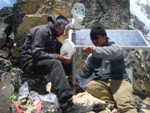
Watch Real-time Video from the Top of Mount Everest
Mount Everest, the highest mountain in the world, is currently the focus of two different projects: The exact height of the mountain will be measured using cutting-edge technology in a project sponsored by the Nepalese government, and as part of the international climate and environmental monitoring conference "Share" (Stations at High Altitude for Research on the Environment), the weather conditions will be documented using a MOBOTIX camera.
The highest webcam in the world brings Everest to the Internet
Although the results of the height measurement may not be available for another two years, you can already see live images from the "Everest Share 2011" research project. Everybody can watch real-time video from the top of Mount Everest right from the comfort of the home computer. A MOBOTIX camera makes this possible and it sets a new record in the process: the operation of the highest webcam in the world at temperatures reaching minus 30 degrees Celsius. The Ev-K2-CNR scientific committee from Bergamo, Italy, installed a type-M12 MOBOTIX camera on nearby Kala Patthar (5,675 meters tall). This camera is currently recording stunning images of the 8,848-meter tall Mount Everest. The video shows Mount Everest as well as the South Col Plateau on the right side of the image. The image is updated every five minutes. The webcam is only active during daylight hours (6:00 a.m. to 6:00 p.m. Nepalese time, which corresponds to 0:15 a.m. to 12:15 p.m. Central European time).
Images for climate protection
The "Everest Share 2011" research project is taking place as part of the international "Share" climate and environmental monitoring conference. Researchers selected Kala Patthar as the camera location because it offers an excellent view of the western side of Mount Everest, including the north and southwest faces of the mountain and the West Ridge. The camera uses a wireless connection to transmit images to the Ev-K2-CNR Pyramid Laboratory/Observatory located at an altitude of 5,050 meters. Here, the video is analyzed and then sent to Italy for further evaluation. Researchers hope to learn more about climate change and global warming using this video, in conjunction with meteorological data, such as temperature and humidity, wind speed and direction, sunlight and precipitation, gathered by the world’s highest weather station (8,000 meters) on Mount Everest.
The best image quality under extreme conditions
Powered by a solar panel, the MOBOTIX camera delivers high-quality images in spite of the icy temperatures, which can reach minus 30 degrees Celsius. Since the camera is robust and flexible, it is ideally suited for harsh environmental conditions. The installation was carried out by Italian engineers together with the Nepalese Ev-K2-CNR team and was coordinated by Giampietro Kohl, leader of the Ev-K2-CNR technical committee.
"We spent months developing the perfect setup for the installation and invested a lot of time testing and verifying the system. And it inspired us on to set a record: operating the highest webcam in the world," Kohl said.